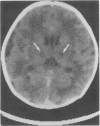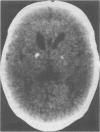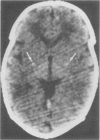Abstract
Clinical observations and findings on imaging are reported in six newborns with symmetrical thalamic lesions (STL). In three cases the diagnosis was confirmed by postmortem examination. Characteristic observations in this series and 17 previously reported cases include no evidence of perinatal asphyxia, high incidence of polyhydramnios, absent suck and swallow, absent primitive reflexes, appreciable spasticity at or within days of birth, lack of psychomotor development, and death within days or months. Characteristic pathological findings include loss of neurons, astrogliosis, and 'incrusted' neurons particularly in the thalamus. In two thirds of cases the basal ganglia and brain stem are involved as well. A hypoxic-ischaemic event occurring two to four weeks before birth is most likely responsible for STL. Bilateral thalamic calcification can often, but not always, be demonstrated in the newborn period by computed tomography and/or cranial ultrasound. The presence of these calcifications and the observation of spasticity at birth imply that the responsible insult occurred at least two to four weeks earlier. The small number of published cases with STL suggest that it may be easily missed.
Full text
PDF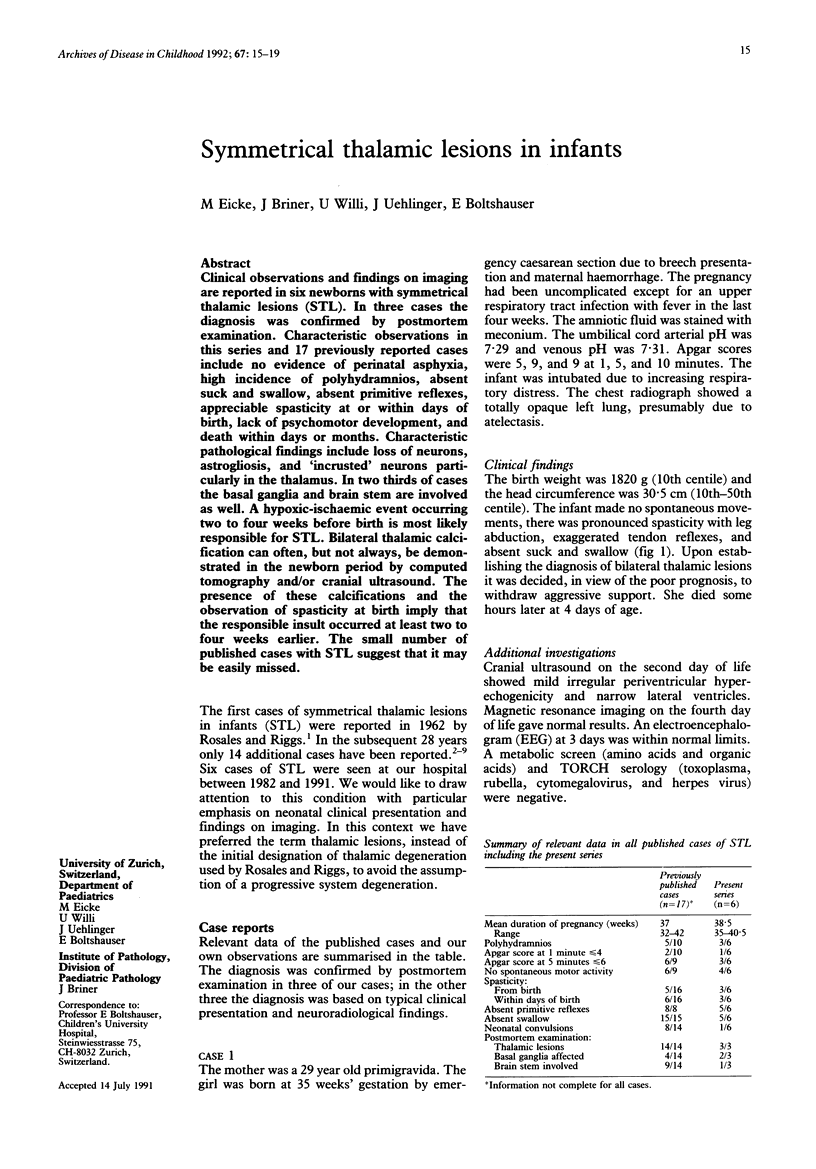
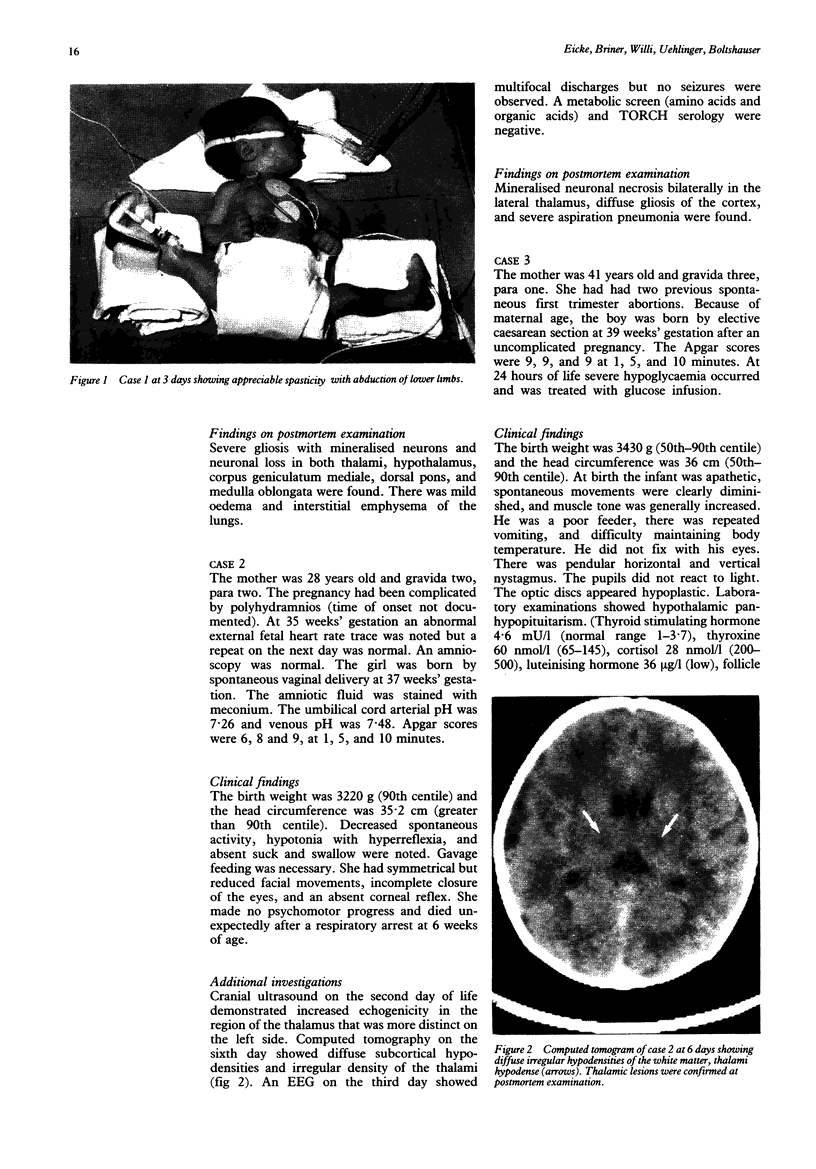
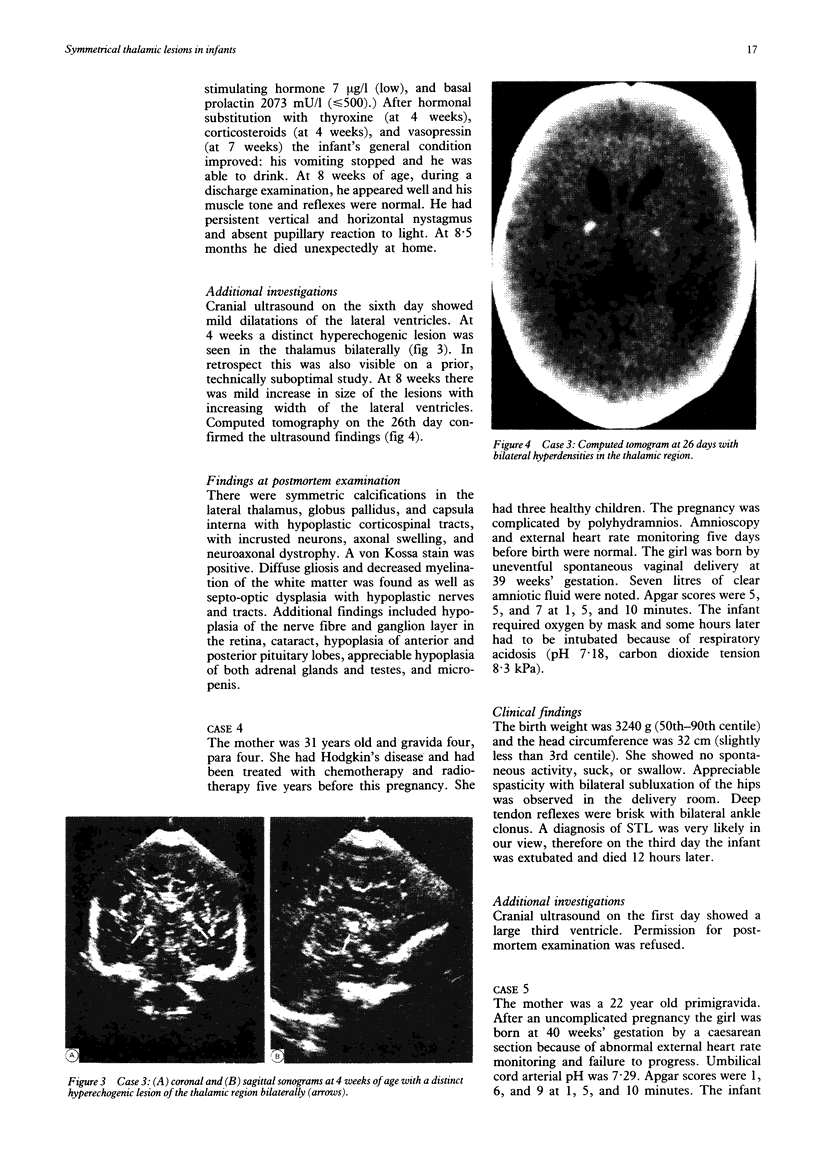
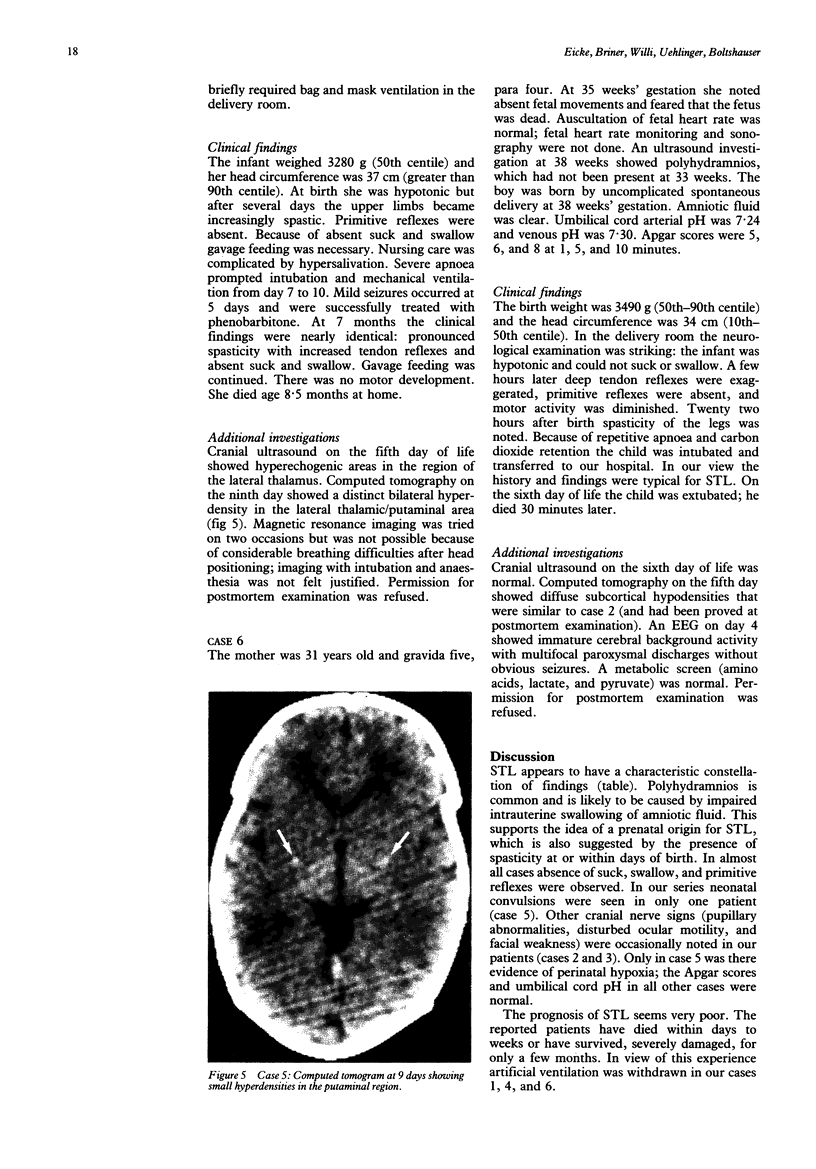
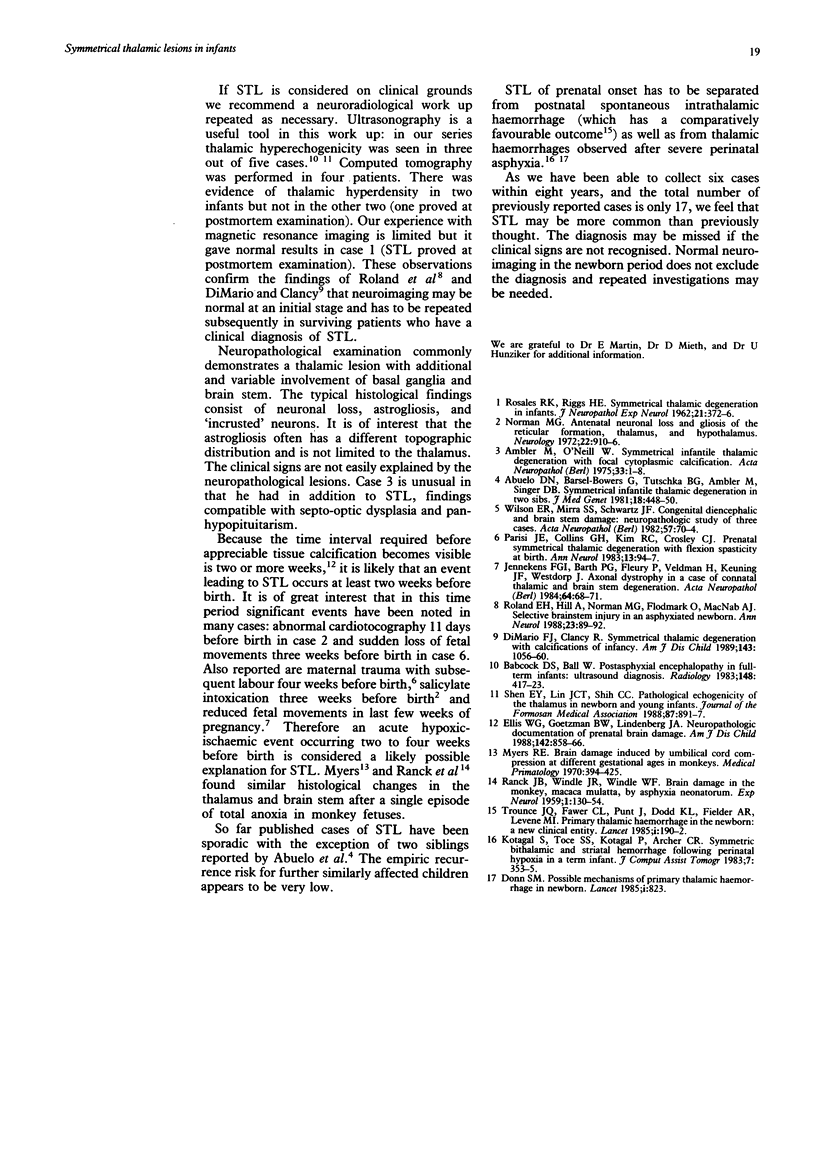
Images in this article
Selected References
These references are in PubMed. This may not be the complete list of references from this article.
- Abuelo D. N., Barsel-Bowers G., Tutschka B. G., Ambler M., Singer D. B. Symmetrical infantile thalamic degeneration in two sibs. J Med Genet. 1981 Dec;18(6):448–450. doi: 10.1136/jmg.18.6.448. [DOI] [PMC free article] [PubMed] [Google Scholar]
- Ambler M., O'Neil W. Symmetrical infantile thalamic degeneration with focal cytoplasmic calcification. Acta Neuropathol. 1975 Oct 27;33(1):1–8. doi: 10.1007/BF00685959. [DOI] [PubMed] [Google Scholar]
- Babcock D. S., Ball W., Jr Postasphyxial encephalopathy in full-term infants: ultrasound diagnosis. Radiology. 1983 Aug;148(2):417–423. doi: 10.1148/radiology.148.2.6867334. [DOI] [PubMed] [Google Scholar]
- DiMario F. J., Jr, Clancy R. Symmetrical thalamic degeneration with calcifications of infancy. Am J Dis Child. 1989 Sep;143(9):1056–1060. doi: 10.1001/archpedi.1989.02150210090024. [DOI] [PubMed] [Google Scholar]
- Donn S. M. Possible mechanisms of primary thalamic haemorrhage in newborn. Lancet. 1985 Apr 6;1(8432):823–823. doi: 10.1016/s0140-6736(85)91486-2. [DOI] [PubMed] [Google Scholar]
- Ellis W. G., Goetzman B. W., Lindenberg J. A. Neuropathologic documentation of prenatal brain damage. Am J Dis Child. 1988 Aug;142(8):858–866. doi: 10.1001/archpedi.1988.02150080064025. [DOI] [PubMed] [Google Scholar]
- Jennekens F. G., Barth P. G., Fleury P., Veldman H., Keuning J. F., Westdorp J. Axonal dystrophy in a case of connatal thalamic and brain stem degeneration. Acta Neuropathol. 1984;64(1):68–71. doi: 10.1007/BF00695608. [DOI] [PubMed] [Google Scholar]
- Kotagal S., Toce S. S., Kotagal P., Archer C. R. Symmetric bithalamic and striatal hemorrhage following perinatal hypoxia in a term infant. J Comput Assist Tomogr. 1983 Apr;7(2):353–355. doi: 10.1097/00004728-198304000-00033. [DOI] [PubMed] [Google Scholar]
- Norman M. G. Antenatal neuronal loss and gliosis of the reticular formation, thalamus, and hypothalamus. A report of three cases. Neurology. 1972 Sep;22(9):910–916. doi: 10.1212/wnl.22.9.910. [DOI] [PubMed] [Google Scholar]
- Parisi J. E., Collins G. H., Kim R. C., Crosley C. J. Prenatal symmetrical thalamic degeneration with flexion spasticity at birth. Ann Neurol. 1983 Jan;13(1):94–97. doi: 10.1002/ana.410130120. [DOI] [PubMed] [Google Scholar]
- RANCK J. B., Jr, WINDLE W. F. Brain damage in the monkey, macaca mulatta, by asphyxia neonatorum. Exp Neurol. 1959 Jun;1(2):130–154. doi: 10.1016/0014-4886(59)90032-9. [DOI] [PubMed] [Google Scholar]
- ROSALES R. K., RIGGS H. E. Symmetrical thalamic degeneration in infants. J Neuropathol Exp Neurol. 1962 Jul;21:372–376. doi: 10.1097/00005072-196207000-00004. [DOI] [PubMed] [Google Scholar]
- Roland E. H., Hill A., Norman M. G., Flodmark O., MacNab A. J. Selective brainstem injury in an asphyxiated newborn. Ann Neurol. 1988 Jan;23(1):89–92. doi: 10.1002/ana.410230115. [DOI] [PubMed] [Google Scholar]
- Shen E. Y., Lin J. C., Shih C. C. Pathological echogenecity of the tahalamus in newborn and young infants. Taiwan Yi Xue Hui Za Zhi. 1988 Sep;87(9):891–897. [PubMed] [Google Scholar]
- Trounce J. Q., Dodd K. L., Fawer C. L., Fielder A. R., Punt J., Levene M. I. Primary thalamic haemorrhage in the newborn: a new clinical entity. Lancet. 1985 Jan 26;1(8422):190–192. doi: 10.1016/s0140-6736(85)92027-6. [DOI] [PubMed] [Google Scholar]
- Wilson E. R., Mirra S. S., Schwartz J. F. Congenital diencephalic and brain stem damage: neuropathologic study of three cases. Acta Neuropathol. 1982;57(1):70–74. doi: 10.1007/BF00688879. [DOI] [PubMed] [Google Scholar]




